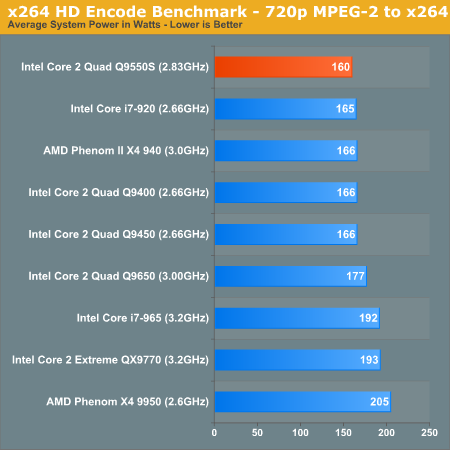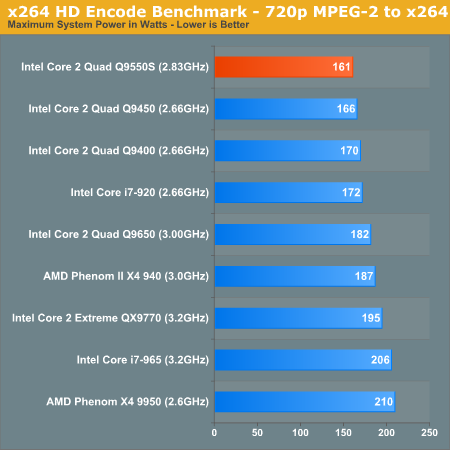Intel Core 2 Quad Q9550S: A New 65W Quad-Core
by Anand Lal Shimpi on January 27, 2009 8:00 PM EST- Posted in
- CPUs
x264 HD Video Encoding Performance
Graysky's x264 HD test uses the publicly available x264 codec (open source alternative to H.264) to encode a 4Mbps 720p MPEG-2 source. The focus here is on quality rather than speed, thus the benchmark uses a 2-pass encode and reports the average frame rate in each pass.
I measured power and performance in the second pass of the benchmark since that’s where the more CPU intensive work gets done.
First, we look at performance:


The Q9550S takes the cake with the lowest average power during the x264 encode, even slightly lower than the Q9400.

Peak power is also lowest on the Q9550S, note that it draws 11W less than the Core i7-920. But the thing to keep in mind is that, once more, the i7-920 is about 40% faster than the Q9550S.
Let’s look at the total energy consumed by the system during the benchmark:

Once again, the two Core i7 platforms offer better energy efficiency than the new Q9550S. In fact, the Q9550S offers about the same energy efficiency as the rest of the Core 2 Quad lineup and AMD’s new Phenom II X4 940. If you want energy efficiency, you actually want a Core i7.










62 Comments
View All Comments
UltraWide - Wednesday, January 28, 2009 - link
why was a normal 95W TDP Q9550 not included???Anand Lal Shimpi - Wednesday, January 28, 2009 - link
I didn't actually have a 95W Q9550 available (Gary has the one we used in our Phenom II review). I provided the Q9650 and the Q9450 so you can get an idea of where the Q9550 would fall.Take care,
Anand
StraightPipe - Thursday, January 29, 2009 - link
I've got to agree with UltraWide.The news is Intel just came up with the S-line of procs.
But the test doesnt compare any S to non-S CPUs...
Isnt that what really matters? the perfomance and power consumption difference between the 95W and the new 65W is what I want to see.
anandtech02148 - Wednesday, January 28, 2009 - link
finally nice to see the pick and choose Anandtech bench, need to take it out of beta, save me a trip to tomshardware.Calin - Wednesday, January 28, 2009 - link
Those processors are perfect as replacements in servers already validated for the 95W version of the same processor. While buying i7 would be better, maybe the i7 servers weren't validated (remember the 3 years of support for business-related hardware lines)danchen - Wednesday, January 28, 2009 - link
looking at the numbers, it doesn't look like its worth the extra money.Its like buying an "environmentally friendly" car - high initial investment, takes many years to get an ROI.
perhaps if you're the type who runs your computers 24/7, it may actually save you some bills in the long run.
rpsgc - Wednesday, January 28, 2009 - link
Or... you could just undervolt your current CPU. Voilà.BTW, what is the default Vcore of these processors?
WillR - Wednesday, January 28, 2009 - link
Depends on the model, but I assume you mean the likes of the Q9550. Those are 1.22V.http://www.anandtech.com/cpuchipsets/showdoc.aspx?...">http://www.anandtech.com/cpuchipsets/showdoc.aspx?... shows a few.
lucassp - Wednesday, January 28, 2009 - link
"the publicly available x264 codec (open source alternative to H.264)"firstly x264 is only an encoder, and doesn't have an encoder included. x264 is an Open Source implementation of the H.264 standard. it's not an alternative to it.
lucassp - Wednesday, January 28, 2009 - link
sorry for the mistake, I meant to say it doesn't have a decoder included ;)